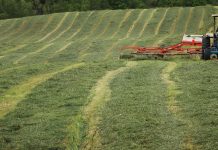I don’t know about you, but my social media feed has been filled recently with ads and videos promoting the benefits of calcium, liquid lime, biological and many other agronomic cure-alls.
Some of the ads use wrong information to sell their product, some stick to the facts and many stretch the truth somewhere in between. I am an advocate for trying new ideas to see if they can make an improvement, but only after doing some basic research to investigate their claims.
Testing
Using a science-based approach to crop nutrition can maximize crop yields while saving you money. The foundation for crop nutrition is regular soil testing every 3-4 years to monitor pH and nutrient levels.
Basic soil tests will typically provide values for pH, phosphorus, potassium, calcium and magnesium. More advanced soil test packages can test for micronutrients, organic matter, sulfur and other values. Testing for micronutrients in the soil can be helpful, but since they are in very low quantities, it can be hard to obtain a good representative sample.
Tissue testing is a powerful tool that should be used more often to diagnose nutrient deficiencies. Tissue testing crops provides a snapshot of the actual nutrients within the plant and is an excellent tool for managing micronutrients.
Soil test and tissue test values should align with each other — sufficient soil values should lead to sufficient tissue nutrient values. This is not always the case, especially in periods of dry weather.
Deficits
Water deficits in and around the root zone will minimize nutrient mineralization and movement. You may have adequate nutrients in the soil, but without water the plants may not be able to access the nutrients.
Here in northeast Ohio, we typically see these types of deficiencies with potassium, magnesium and sulfur but can occur with other nutrients. It may be tempting to apply rescue fertilizer when these deficiencies appear, but more than likely crops will grow out of these drought-induced deficiencies after adequate rain.
Some nutrient deficiencies present very unique symptoms such as purple leaves with phosphorus deficiency.
Other deficiencies can present similar symptoms that can be difficult to differentiate, and this is where tissue testing provides clarity on what is going on inside the plant.
Soil testing in combination with tissue testing will provide a more complete picture of crop nutrition. With this information you can further refine your nutrient management strategy to ensure crop nutrition is not limiting your yield potential.
Best approach
Liebig’s law of the minimum states that a barrel will only hold water (crop yield) to it’s lowest stave (nutrients and other factors). By identifying the lowest stave, you can make adjustments to your fertility program to raise the limiting nutrient to maximize yield. You can read more about this soil fertility principle at https://ohioline.osu.edu/factsheet/anr-0136.
Some advocates promote the use of excess calcium to increase yields. But if calcium is not your lowest stave on the barrel, adding more will not increase yields. This is true for all nutrients.
Adding excess nutrients will not create a bigger barrel for more yield — the size of the barrel is determined by plant genetics. Even with perfect soil and crop fertility, the lowest stave on the barrel will likely be environmental factors (moisture, heat, compaction, pest pressure, etc.).
Some of those can be controlled with pesticides or irrigation, but most will be out of our control.
Incorporating a science-based approach can also help you evaluate some of those promoted products. Rather than apply the products to your entire field, consider trying some on-farm research of your own.
Apply the new products in strips and compare the results to non-treated areas within the same field. That will help you distinguish between the marketing and any real improvements.













